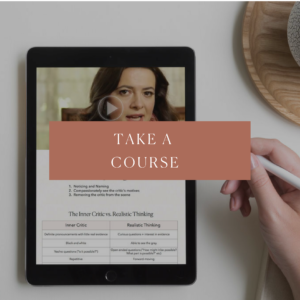“Honey, want to set the table?”
That’s what we say, but what we really mean is
“Honey, I’d like you to set the table. Would you be willing to do that?”
Or we say,
“Let’s go hiking today.”
when what we really mean is
“I’d love to go hiking! Are you up for that?”
We say,
“We should do our taxes this weekend.”
When what we really mean is
“I feel stressed about the taxes and would like to get them done. Would you be up for doing them together this weekend?”
Read over these statements again. Notice how it feels to you to imagine saying the first question in each pairing, and then what feels different when you imagine saying the second.
For most of us, it feels much more comfortable to ask the first in each pair of questions.
But do you notice what’s missing in each of these statements? The “I.” And as a result, the truth is missing too.
Most of the time, we don’t express our requests or our preferences explicitly. We blur them, hide them, couch them.
Sometimes we do that because deep down, we aren’t sure if the request is fair. We feel guilty about it. Or we don’t want the disappointment or frustration of a clear “no” – so we don’t frame our requests as questions at all. Much of the time, we are uncomfortable simply because making requests is vulnerable — it requires sharing openly what we want, and, in some way, asking for help, for teamwork. It is also difficult, because it puts the responsibility on us to discern what we want and ask for it rather than being vague about it and expecting our loved ones to just get it.
So we skip the actual requesting part. We also skip the part where we insert an “I” into the sentence and say what we want.
This has big-time problematic effects in our relationships.
You say, “Honey, want to take some time off so we can reconnect?” when you mean, “Would you please take some time off so we can reconnect?” “Honey” has two options:
1. Answer your question literally. Honey’s answer is likely “no” since he or she probably doesn’t actively want the exact same thing you just dreamed up. The problem is, you’ll receive that no as a dismissal of what you were really feeling, which was “I’m feeling disconnected. I want to do something about it. My request is that maybe you could take time off and we could spend time together. Would you be willing to do that?”
2. The other option is for honey to play into the “code” language here and understand you are really making a request of them, even though you haven’t said it that way. This is a kind of “we know each other so well, I know what she is really saying” thing that many couples get into. They learn to read many of each other’s weird ways of saying things – through words, facial expressions, sighs, and behavior. But we don’t want to be doing interpretative guesswork about what our loved ones are saying, because a lot of the time we’ll guess wrong — and then they’ll feel misunderstood, unseen, or unloved. Guesswork also deprives us each of the powerful experience of figuring out what we want and articulating it, and the beautiful experience of being able to meet a partner’s request.
So here ‘s my challenge to you for the week:
1. No more saying, “Want to blah blah blah?” when what you really mean is, “Would you be willing to do blah blah blah?” Instead, say what you mean, “Would you be willing to do blah blah blah?”
Remember your partner can answer yes or no, and then it’s up to you to decide what you want to do from there. You may feel sad, disappointed, angry or other difficult emotions when you get a “no” – and– your partner is not responsible for your emotions. Similarly, your partner may have requests of you, and you get to answer yes or no, based on what feels right to you. They may have emotions in response to your “no” and that’s okay – you aren’t responsible for those emotions.
2. No more saying “Let’s do x” when you want to say, “I’d like to do x.’ Instead, say, “I’d like to do x.” What follows depends on the situation. It might be, “I’d like for you to come. Would you be willing to join me?” It might be, “You are welcome to come if you want.”
3. And last but not least, no more, “We should…” That statement is never, ever, true. What might be true is that there is something you want, or something you think you and so and so should do. But there is no such thing as “We should.” So say what you mean: “I’d like us to…” or “I think the right thing to do here is x.”
Use your “I’s.” Be clean in your communication: say what you mean. Start practicing the art of identifying and expressing your requests.
What do you think about giving this a try? What does this post bring up for you? Let me know in the comments.
Join Me for an Open Rehearsal
AND I have a fun invitation for you! Later this week, Jennifer Siebel Newsom and I will be giving the keynote talks at the California conference for the American Association of University Women. I am having an “open rehearsal” of my talk tomorrow morning at 8-9am PST, by conference call. If you’d like to listen in, register for free access here. The talk is about women playing bigger, about how we can step into our callings, and about how I see the next frontier of the women’s movement. Register for the open rehearsal HERE. (Note: There will be no recording of this call available, unfortunately. If you can’t attend April 10, 8-9am PST live, please stay tuned for other opportunities to listen to this content.)
Love,
Tara






Wow I am absolutely guilty of this! The vulnerability that someone might think what I want to do is stupid. Why do I worry about that? I miss out on the possibility that someone might say yes and actually relate to me! No more, thanks for putting into words how I feel Tara x
I do this all the time too, Tara, and have been more aware of it recently.
What occurred to me is that I do this a lot with my kids (now adults), and that by doing so, I am teaching them to communicate in this way.
Also, the first way sets the other person up for disappointing you, while the second way is much more respectful, recognizing that the other person has their own needs.
Thanks, Tara. I am going to be aware of this today.
Tara, this is amazing and a wonderful reminder. Say what you mean.
this piece was timely! I realized reading it that I do exactly what you shouldn’t do all the time. I’ve been realizing lately how hard it is for me to ask for things–“ask” in this sense means more than just simple requests, but also major desires or goals. But it spills over, or trickles down, if you will, into more minor requests.
I am going to give it a try. I’m already formulating how to suggest the logistics of our afternoon and evening to my husband in a way that is clearer about what would be helpful to me, while also trying to be courteous to him. Thanks
I think for women it can be especially difficult to clearly state what we want because a lot of us have been brought up to think that it’s somehow wrong for us to have needs or to want anything for ourselves.
We’re supposed to be looking after other people’s needs, not expressing our own.
I’m working my way towards clarity in part by studying Non-Violent Communication, which is all about connecting with what we need, moment by moment.
This piece was a lovely, clear explanation of the right way to make a request. Thanks Tara!
I actually communicate like this (which was interesting for me to read) and it’s deliciously liberating for both of us. He can say “yes” or “no” if he wants to join – but I can go and that then if I want to..never been a a big fan of “we should”. As I say, we are wedded not welded…
You have expressed so well the remedy to one of my relationship/communication pet peeves!
Tara so well said! The art of communicate is a two party affair!
thanks for this.
When I turned fifty in october I decided exactly this….to say what I mean, with the I in place! I don’t pussyfoot around things anymore. It has left me many times with the other party (a man) feeling as if I am being “bossy” but I do have wants and needs and desires and I want them known. Thank you for confirming my feelings and thoughts. Tara you are so inspirtational!
This is great advice, Tara. It’s so important for not only adults to advocate for the ‘I’, but to teach our children how to do it as well. I want my teenage daughter to learn how to always be her best advocate!
Soggy Potato chips…
ttp://bootsnbikes.wordpress.com/2011/07/20/soggy-potato-chips/
http://bootsnbikes.wordpress.com/2011/07/20/soggy-potato-chips/
Tara, thanks for this. It is certainly a lot freeing – for both of us – when my husband and I communicate with clarity around our wants and needs. Thanks for adding even more to my awareness.